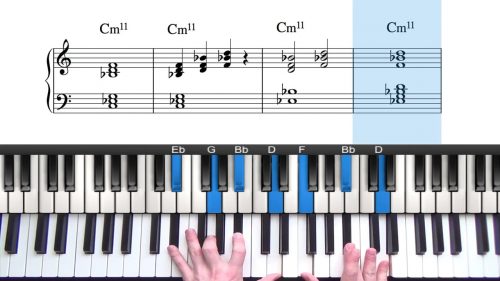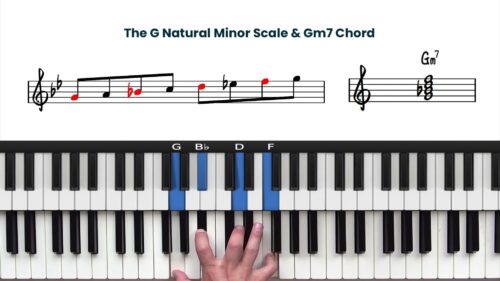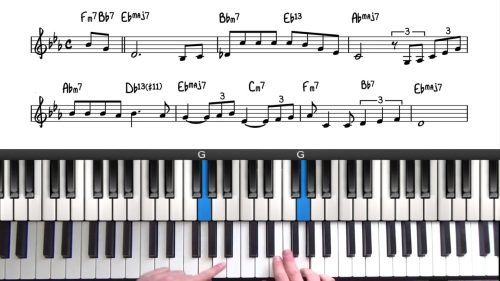Slash Chords Jazz Piano Lesson
All slash chords contain 2 bits of information. The first letter that is on the left hand side of the slash, indicates what chord should be played. The second letter that is on the right hand side of the slash indicates what note should be played in your left hand or in the bass.
Something to be aware of is that slash chords are commonly used as shorthand. So if you are reading a lead sheet and you come across Cmaj13#11 — that is a lot of information to process. Alternatively, reading the chord as D/C tells you the exact same chord but just with much less information.
As you are exposed to more slash chords you will be able to quickly analyse them in terms of the extensions and the alterations.
What Are Slash Chords?
The first category of slash chords is when the bass note is one of the primary chord tones of the chord to the left of the slash. When this is the case, the chord is simply an inversion.
The second category of slash chords is when the bass note is not part of the chord to the left of the slash. ie. the bass note is not one of the primary chord tones of the chord to the left of the slash. When this is the case, you should always analyse the chord as if the bass note is the root of the chord.
Slash Chords Containing Major 7ths
It’s also common to have 7th chord within slash notation. These are dealt with in the exact same way that we deal with the triads.
If the bass note is one of the primary chord tones of the 7th chord to the left of the slash, ie. Root, 3rd, 5th, or 7th — then we simply play an inversion of the 7th chord.
Slash Chords Bass Line Movement
Slash chords are also commonly used to achieve specific step-wise or chromatic bass line movement. Whenever you come across a slash chord, analyse the bass line in the progression to see where it is going.
Looking at the opening bars of My One & Only Love that I was playing in the intro, I have highlighted the roots of the chords, or the implied bass notes. We can see that the slash chords create a descending step wise bass line.
Practice Tips
-
Flick through your jazz fakebook and when you find slash chord, analyse the chord and work out whether the bass note is part of the chord to the left of the slash. If it's not then try to work out what chord is being implied.
-
Next examine the bass line movement and try to identify any step wise or chromatic bass lines.
- Finally, try to play the measure where the slash chord appears.







Thanks, Hayden!
Question on slash chords: When playing with a bass player, should you leave the new root note out of the chord (or bottom of the chord) like usual? Or rather, how does this information apply when forming left hand rootless voicings?
I’m thinking specifically about On Green Dolphin Street – I’m currently learning the song, and going through the left hand rootless voicings.
So, for the F7#11/Eb, my instinct is to play the rootless voicing off the Eb (Eb, G, A, C), and the E7#11/Eb (D, F#, G#, B) – but bc of the the above question, I’m thinking it might be more appropriate to play those off the major 3rds, A and G#, respectively.
And, a similar question in bars 25 and 27, in regards to the -7 /Eb, and C-7 /Bb.
Thanks in advance!
Best,
Clif
Hi Cliff,
Great question here.
For the example F7#11/Eb, when playing with a bass player it would be fine to play the Eb on the bottom of your rootless voicing.
The reason is that we play rootless voicings in the centre of piano, as close to middle C as possible which is where they sound best.
This region of the piano is way above the range of the bass player and so the note choices that we play in our rootless voicings would not interfere with the bass lines that are being played in the lower registers by the bass player.
Again it’s always best to practice this stuff with a bass player and make your own mind up. There are a somewhat limited number of rootless voicing options for F7#11 and so I would recommend trying them all and then following your ears on what sounds best.
I hope that helps and let me know if you have any other questions.
Cheers,
Hayden
Got it. This totally answers my question – really helpful to know.
Thanks again!
Best,
Clif